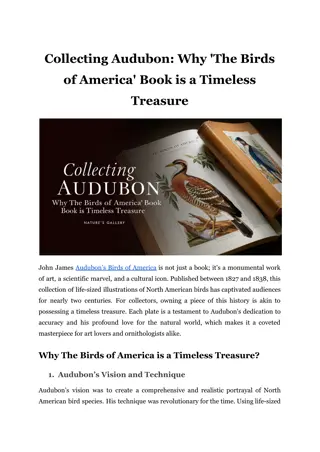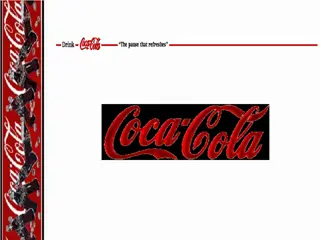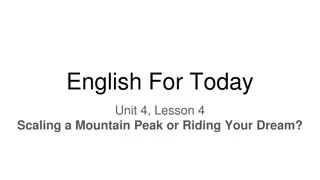
Icon Programming Language History and Design Philosophy
Explore the fascinating history and design philosophy behind the development of the Icon programming language at the University of Arizona in the 1970s. Learn about its roots in SL5, supported by the National Science Foundation, and the emphasis on ease of use and problem orientation in its design. Discover how Icon's efficient design was a response to the limited computing resources of its time, making it a significant language in the evolution of programming.
Download Presentation

Please find below an Image/Link to download the presentation.
The content on the website is provided AS IS for your information and personal use only. It may not be sold, licensed, or shared on other websites without obtaining consent from the author. If you encounter any issues during the download, it is possible that the publisher has removed the file from their server.
You are allowed to download the files provided on this website for personal or commercial use, subject to the condition that they are used lawfully. All files are the property of their respective owners.
The content on the website is provided AS IS for your information and personal use only. It may not be sold, licensed, or shared on other websites without obtaining consent from the author.
E N D
Presentation Transcript
Icon CSC 372, Spring 2023 The University of Arizona William H. Mitchell whm@cs CSC 372 Spring 2023, Icon Slide 1
A little history SL5 (SNOBOL Language 5) was developed at UA in the early 1970s. "SL5 had everything" An example of the second-system effect Never released Ralph thought, "There must be something simpler." The Icon programming language That "simpler" thing Designed in mid/late 1970s by a team led by Ralph An example of expansion followed by contraction Two research focuses with Icon: High level programming language facilities Portable software Icon implementation: First implemented in Ratfor (rational Fortran), to facilitate "porting" Later reimplemented in C, but with hundreds of lines of assembler CSC 372 Spring 2023, Icon Slide 2
History, continued The development of Icon was supported by about a decade of funding by the National Science Foundation. Your grandparents paid for Icon. (Thanks!) Icon was placed in the public domain. (Open source before it was cool!) Ralph himself mailed thousands of Icon tapes ("download"?) Today: Classic Icon is alive and well. Unicon (Unified Extended Icon) has support for object-oriented programming, systems programming, and programming-in-the-large. Clint Jeffery leads Unicon development. Todd Proebsting and Gregg Townsend developed Goaldi ("goal- directed") in 2015. CSC 372 Spring 2023, Icon Slide 3
Design philosophy Ralph wrote the following about SNOBOL4, but I see the same view manifested in Icon (perhaps minus the second point). "A main philosophical view emerged in the early design efforts: ease of use. To us, this implied several design criteria: 1. Conciseness: the language should have a small vocabulary and express high-level operations with a minimum of verbiage. 2. Simplicity: the language should be easy to learn and use 3. Problem orientation: the language facilities should be phrased in terms of the operations needed to solve the problem, not the idiosyncrasies of computers. 4. Flexibility: users should be able to specify desired operations even if these operations are difficult to implement. [...]" CSC 372 Spring 2023, Icon Slide 4
Design philosophy, continued Continuing... "These objectives had several consequences, most of which can be characterized as a disregard for implementation problems and efficiency. This was a conscious decision and was justified by our contention that human resources were more precious than machine resources, especially in research applications where SNOBOL was expected to be used." How much more expensive were machine resources then (the 1960s) vs. now? CSC 372 Spring 2023, Icon Slide 5
Efficiency by virtue of limited resources Compared to today, computing resources were very limited when Icon was developed. The Ratfor implementation of Icon was developed on PDP-10 mainframe: About 1.5 MIPS Maybe a megabyte or two of virtual address space Campus-wide timesharing system The C implementation of Icon was developed on a PDP-11/70 owned by the CS department: Perhaps 1 MIP 64 kbytes for program code / 64 kbytes for data ("split I/D") Icon's implementation was small and efficient by nature due to these limits. CSC 372 Spring 2023, Icon Slide 6
A little Icon by observation % /cs/www/classes/cs372/spring23/bin/ie -nn Icon Evaluator, Version 1.1, ? for help ][ 3 + 4 > (optab icon + IRS) + | I R S ---+--------- I | I R I R | R R R S | I R I ][ 3 + "4.5" ][ 3 || "4.5" > (optab icon "||" IRS) || | I R S ---+--------- I | S S S R | S S S S | S S S CSC 372 Spring 2023, Icon Slide 7
Icon by observation, continued ][ &pi r := 3.141592654 (real) ][ &dateline r := "Friday, April 28, 2023 12:32 pm" (string) ][ type(r) r := "string" (string) ][ type(type) r := "procedure" (string) CSC 372 Spring 2023, Icon Slide 8
Icon by observation, continued ][ s := "testing" r := "testing" (string) ][ *s ][ s[-1] ][ s[1] CSC 372 Spring 2023, Icon Slide 9
Sidebar: Zero- vs. one-based indexing What should the index of the first element of a string/array/list be? Let's vote! Zero? One? Based on its declaration? (Pascal: var a: array[low..high] of int) Ralph said something like, "People count from one." In a linear algebra text, what's the upper-leftmost element in a matrix a? FORTRAN, COBOL, APL, PL/I, SNOBOL4, Algol 68, Smalltalk and many other early languages used one-based indexing. How did we end up with this zero-based madness, including abominations like "zeroth"? (Don't peek!) CSC 372 Spring 2023, Icon Slide 10
Sidebar, continued "Array subscripts start at zero in C (rather than at 1 as in Fortran or PL/I), ..." First edition of The C Programming Language" by K&R, p. 20 Why does zero-based indexing make sense in C? When you first learned to program, did you think zero-based indexing was odd? CSC 372 Spring 2023, Icon Slide 11
String subscripting In Icon, positions in a string are between characters and run in both directions. 1 2 3 4 5 6 7 8 | | | | | | | | t o o l k i t | | | | | | | | -7 -6 -5 -4 -3 -2 -1 0 (s := "toolkit") Several forms of subscripting are provided. ][ s[3:-1] What's the Python analog for this? ][ s[5:0] ][ s[1+:4] s[i] is a shorthand for s[i:i+1] ][ s[5] Observations? What problem does between-based positioning avoid? It avoids the trouble with "to" vs. "through", "inclusive" vs. "exclusive", etc. CSC 372 Spring 2023, Icon Slide 12
Strings are mutable! Any substring can be the target of an assignment. ][ s := "mudge" ][ s[-1] := "ingly" ][ s[1] := "gr" ][ s ][ s ][ s[4:0] := "" ][ s[1:1] := "be" ][ s ][ s CSC 372 Spring 2023, Icon Slide 13
Strings have "value semantics" Assignment of string values does not cause sharing of data: ][ x := "test" r := "test" (string) ][ y := x ][ x[1] := "p" ][ x r := "pest" (string) ][ y r := "test" (string) CSC 372 Spring 2023, Icon Slide 14
Lists, by observation ][ x := [10, [20], "thirty"] r := L1:[10,L2:[20],"thirty"] (list) ][ push(x, 5) ][ x[2:4] r := L1:[10,L2:[20]] (list) ][ *(x ||| x) ][ put(x, x) r := L1:[5,10,L2:[20],"thirty",L1] (list) In contrast to strings, lists have reference semantics. CSC 372 Spring 2023, Icon Slide 15
Character sets, by observation ][ 'tim korb' ][ &lcase -- 'aeiou' ][ split("(520) 621-4632", '- ()') ][ split("Friday, 04/28/23", ~&digits) ][ *(&letters ++ &digits) CSC 372 Spring 2023, Icon Slide 16
Tables, by observation ][ t := table("Go fish!") r := T1:[] (table) ][ t["one"] := 1 ][ t['two'] := 2 ][ t r := T1:["one"->1,'otw'->2] (table) ][ t["three"] r := "Go fish!" (string) ][ t[t] := t r := T1:["one"->1,'otw'->2,T1->T1] (table) CSC 372 Spring 2023, Icon Slide 17
Failure A cornerstone of Icon: An expression can fail to produce a result. A simple example is an out of bounds string subscript: ][ s := "testing" ][ s[50] Failure We say, "s[50]fails" it produces no value. If an expression produces a value it is said to have succeeded. When an expression is evaluated it either succeeds or fails. CSC 372 Spring 2023, Icon Slide 18
Failure, continued An important rule: An operation is performed only if a value is present for all operands. If due to failure a value is not present for all operands, the operation fails. Another way to say it: If evaluation of an operand fails, the operation fails. And, failure propagates. ][ s := "testing" When working in Icon, unexpected failure is the root of madness. ][ "x" || s[50] Failure ][ reverse("x" || s[50]) Failure ][ s := reverse("x" || s[50]) Failure # s is unchanged CSC 372 Spring 2023, Icon Slide 19
Failure, continued Here's a string that represents a hierarchical data structure: "/a:b/apple:orange/10:2:4/xyz/" Major elements are delimited by slashes; minor elements are delimited by colons. Imagine an Icon procedure to get an element given a major and minor: ][ extract("/a:b/apple:orange/10:2:4/xyz/", 2, 1) ][ extract("/a:b/apple:orange/10:2:4/xyz/", 3, 4) Implementation: procedure extract(s, m, n) return split(split(s, '/')[m], ':')[n] end How does extract make use of failure? CSC 372 Spring 2023, Icon Slide 20
The while expression Icon has several traditionally-named control structures, but they are driven by success and failure. Here's a loop that reads lines and prints them: while line := read() do write(line) Here's a more concise version: while write(read()) What causes termination of the loop? 1. read() fails at end of file. 2. That failure propagates outward, causing the write() to fail. 3. The while terminates because its control expression, write(...), failed. CSC 372 Spring 2023, Icon Slide 21
Generators In most languages, evaluation of an expression produces either a result or an exception. We've seen that Icon expressions can fail, producing no result. Some expressions in Icon are generators, and can produce many results. Here's a generator: 1 to 3 1 to 3 has the result sequence{1, 2, 3}. Here are two more generators. What are their result sequences? !"abc" 10 | 2 | 4 CSC 372 Spring 2023, Icon Slide 22
Generator basics, continued The every control structure drives a generator to failure, making it produce all its results. Example: every i := 1 to 5 do write(repl("*", i)) Output: * ** *** **** ***** Can you make it more concise? CSC 372 Spring 2023, Icon Slide 23
"bang", continued Speculate: What does the following program do? procedure main() lines := [] every push(lines, !&input) every write(!lines) end Execution: % seq 3 | icon tac.icn 3 2 1 % CSC 372 Spring 2023, Icon Slide 24
Multiple generators An expression may contain any number of generators: ][ a := !"cat" & b := !"toc" & a ~== b & write(a, "-", b) & 1 = 0 c-t c-o a-t a-o a-c t-o t-c Failure Generators are resumed in a LIFO manner: the generator that most recently produced a result is the first one resumed. Does the example above remind you of anything? CSC 372 Spring 2023, Icon Slide 25
Multiple generators, continued Here's a program that counts vowels on standard input: $ echo just testing | icon vowcount.icn 3 vowels Implementation, with multiple generators: procedure main() vowels := 0 every !!&input == !"aeiou" do vowels +:= 1 write(vowels, " vowels") end Key point: In Icon, any expression in any context can be a generator. Ralph would say, "completely and perfectly general" Contrast: Some languages provide "generators" but they can be only be used in certain contexts, such as a "for" statement. CSC 372 Spring 2023, Icon Slide 26
The N queens problem Problem: In chess, how can N queens be placed on an NxN board such that no queen is attacking any other? --------------------- | | | | | Q | --------------------- | | | Q | | | --------------------- | Q | | | | | --------------------- | | | | Q | | --------------------- | | Q | | | | --------------------- Here's a 5x5 solution: CSC 372 Spring 2023, Icon Slide 27
N queens, continued An Icon solution by Steve Wampler is in spring23/icon/queens.icn. This is the placement procedure, called with q(1) initially. procedure q(c) static up, down, rows initial { up := list(2*n-1, 0) down := list(2*n-1, 0) rows := list(n, 0) } every 0 = rows[r := 1 to n] = up[n+r-c] = down[r+c-1] & rows[r] <- up[n+r-c] <- down[r+c-1] <- 1 do { solution[c] := r # record placement. if c = n then show() else q(c + 1) # try to place next queen. } end Try it: icon queens.icn -n 10 CSC 372 Spring 2023, Icon Slide 28
String scanning SNOBOL4 is really two languages in one: A general purpose programming language A pattern matching language Languages with support for regular expressions are similarly divided: A general purpose programming language A regular expression facility A design goal for Icon was to integrate string pattern matching with regular computation: Match a little, compute a little, match a little, compute a little, etc. The end result: A handful of string scanning procedures that can be used in conjunction with Icon's other facilities to achieve a seamless interleaving of string pattern matching with regular computation. Unrestricted languages ("type(0)") can be recognized with scanning. CSC 372 Spring 2023, Icon Slide 29
parse_time Imagine an Icon procedure that parses a time and returns a list of the pieces: ][ parse_time("4:24pm") r := ["4","24","pm"] (list) Invalid or omitted elements result in failure: ][ parse_time("4:24") Failure ][ parse_time("12:60pm") Failure ][ parse_time("1o:45xm") Failure ][ parse_time("3:45pm.") Failure CSC 372 Spring 2023, Icon Slide 30
Wanted: ][ parse_time("12:34pm") r := L1:["12","34","pm"] (list) Here's a solution with string scanning: procedure parse_time(s) s ? { hours := tab(many(&digits)) & 1 <= hours <= 12 & =":" & mins := tab(many(&digits)) & 0 <= mins < 60 & ampm := =("am"|"pm") & pos(0) } & return [hours, mins, ampm] end CSC 372 Spring 2023, Icon Slide 31
sumnums.icn Imagine a procedure that sums the integers it finds in a string: ][ sumnums("values: 10, 20 and 30") r := 60 (integer) Solution: procedure sumnums(s) sum := 0 s ? while tab(upto(&digits)) do sum +:= tab(many(&digits)) return sum end A goal of string scanning was to be able to interleave scanning operations with ordinary computation. Does sumnums exemplify that? CSC 372 Spring 2023, Icon Slide 32
Summary of string scanning in Icon There is a set of procedures that produce positions to be used in conjunction with tab(n): many(cs) produces position after run of characters in cs upto(cs) generates positions of characters in cs find(s) generates positions of s match(s) produces position after s, if s is next any(cs) produces position after a character in cs bal(s, cs1, cs2, cs3) similar to upto(cs), but used with "balanced" strings. There is one other string scanning procedure: pos(n) tests if &pos is equivalent to n The string scanning facility consists of only the above procedures, move(n), the ? scanning operator, and the &pos and &subject keywords. Nothing more. CSC 372 Spring 2023, Icon Slide 33
Disappointment Ultimately, Icon's string scanning facility was a disappointment. Small and powerful Implementation of scanning itself is nearly trivial Did achieve interleaving of matching and computation But non-trivial techniques and idioms must be learned Some pitfalls For me, first version often not correct Is there a sweet spot with primitives and techniques? Regular expressions: Lots of primitives Relatively few techniques Icon's string scanning: Very few primitives Many techniques SNOBOL4 patterns: A few primitives A few techniques CSC 372 Spring 2023, Icon Slide 34
Graphics in Icon Facilities for graphical programming in Icon evolved in the period 1990- 1994. A philosophy of Icon is to insulate the programmer from details and place the burden on the language implementation. The graphics facilities were designed with same philosophy. Icon's graphical facilities are built on the X Window System on UNIX machines. On Microsoft Windows platforms the facilities are built on the Windows API. CSC 372 Spring 2023, Icon Slide 35
Graphics, continued Here is a program that randomly draws points: (blackout.icn) link graphics $define Height 500 # symbolic constants $define Width 500 # via preprocessor procedure main() WOpen("size=" || Width ||","||Height) # blackout.icn repeat { DrawPoint(?Width-1, ?Height-1) } end Speculate: How long will it take it to black out every single point? CSC 372 Spring 2023, Icon Slide 36
Simple game $define Width 500 $define Height 500 procedure main() # g3.icn WOpen("size="||Width||","||Height, "drawop=reverse") x := ?Width; y := ?Height; r := 50 repeat { DrawCircle(x, y, r) hit := &null every 1 to 80 do { WDelay(10) while *Pending() > 0 do { if Event()=== &lpress then { if sqrt((x - &x)^2 + (y - &y)^2) < r then { FillCircle(x, y, r) WDelay(500) FillCircle(x, y, r) hit := 1 break break }}}} DrawCircle(x,y,r) if \hit then r *:= .9 else r *:= 1.10 x := ?Width; y := ?Height } end # targetgame.icn This program draws a circular target at random location If the player clicks inside the target within 800ms, the radius shrinks by 10%. If not, the radius grows by 10%. CSC 372 Spring 2023, Icon Slide 37
Kobes' Curve Editor Steve Kobes wrote this very elegant curve editor in 2003: procedure main() WOpen("height=500", "width=700", "label=Curve Editor") pts := [] repeat case Event() of { &lpress: if not(i := nearpt(&x, &y, pts)) then { pts |||:= [&x, &y]; draw(pts)} &ldrag: if \i then { pts[i] := &x; pts[i + 1] := &y; draw(pts) } !"Qq": break } end procedure draw(pts) EraseArea() DrawCurve!(pts ||| [pts[1], pts[2]]) every i := 1 to *pts by 2 do FillCircle(pts[i], pts[i + 1], 3) end procedure nearpt(x, y, pts) every i := 1 to *pts by 2 do if abs(x - pts[i]) < 4 & abs(y - pts[i + 1]) < 4 then return i end CSC 372 Spring 2023, Icon Slide 38
Icon takeaways I'd like you to know: A three-word description of Icon: "Python meets Prolog" Icon strings are mutable, but references aren't shared. I say that this is The Right Way to do strings. An Icon expression can fail, and produce no result. Failure propagates. Icon has generators, which can produce more than one result. A generator can appear anywhere, not just in particular constructs. Icon's string scanning facility interleaves string analysis operations with regular computation. CSC 372 Spring 2023, Icon Slide 39
Icon resources cs.arizona.edu/icon is the Icon home page. cs.arizona.edu/~whm/451 has the materials from a full-semester course I taught on Icon in 2003. On the Icon home page, under "Books About Icon", I recommend three: The Icon Programming Language, 3rd edition A comprehensive treatment of the language, with numerous examples of non-numerical applications. The Implementation of the Icon Programming Language For a time, Ralph taught a course that covered the implementation of Icon's run-time system. This book rose out of that course. If you're interested in the implementation of dynamic languages, this book is definitely worth a look. Graphics Programming in Icon Some parts are dated but lots of interesting stuff, like Lindenmayer systems and a caricature algorithm. unicon.org is the home page for Unicon. CSC 372 Spring 2023, Icon Slide 40










